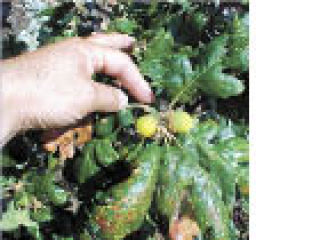When Smithsonian naturalist C.B.R. Kennerly visited San Juan Island in 1860, his hosts at Camp Pickett insisted that he visit the “Oak Prairie”, five bone-rattling horseback miles into the interior through swampy wetlands and meadows overgrown with ferns. At the headwaters of False Bay, Kennerly found several square miles of scattered oaks. Where and what exactly was the Oak Prairie? Was it the principal, or perhaps the only oak-dominated landscape in San Juan County 150 years ago?
Near the intersections of Old Schoolhouse Road and Valley Farms Road with San Juan Valley Road, you can see scores of large Garry oaks scattered around farm pastures, mainly on the thin, well-drained soils of small rounded knobs or ridges. Their location is consistent with Kennerly’s notes. Early farmers cleared many oaks to plant pastures with European forage grasses, now the dominant plant species. Acorns are good forage for livestock, however, so oaks may have been given preference over other woody species. Fire scars in tree rings show that Coast Salish people probably fire-cleared the underbrush about every 10 years on Disney and south Lopez, probably to maintain accessible deer parks for hunting since there is no archaeological evidence of acorn use in San Juan Islands. But oaks may have colonized clearings. Logging of firs in the late 19th century would have created a window of opportunity for widespread oak regeneration, and created most of the oak patches that today are slowly disappearing back under fir canopies.
We have also observed that most seedlings are very close to established trees: do island oaks have enough animals to disperse their acorns? The best acorn dispersers are animals that cache or bury acorns rather than eating them immediately, such as Stellar’s jays, once abundant in the islands but now largely restricted to west Orcas; and Northern flying squirrels, thus far seen only at higher elevations of San Juan Island and Blakeley.
Understanding and conserving our native oaks is important for wildlife that relies on acorns for fall sustenance, such as Band-tailed pigeons. Russel Barsh and Madrona Murphy study Garry oak ecology for Kwiáht and are associated with the Victoria-based Garry Oak Ecosystem Restoration Team (GOERT). Russel is editing the Kennerly diaries and field notes for publication.



